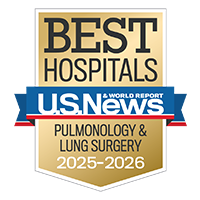Asbestosis

Overview
Asbestosis is caused by long-term, repeated exposure to asbestos, a natural fiber that is used for various industrial purposes, such as insulation and car brake linings. Fibers of asbestos in the air are inhaled and become lodged in the lungs. As a result, lung tissue is scarred and lungs are unable to contract and expand normally. Asbestosis also increases a person's chance of developing asbestos lung cancer and malignant mesothelioma, a rare form of cancer almost always caused by asbestos.
Our approach to asbestosis
UCSF provides comprehensive evaluations and care for work-related lung diseases, such as asbestosis. We offer a wide range of pulmonary function tests as well as flexible bronchoscopy to examine the airways.
When treating asbestosis, the first step is to avoid any further exposure to asbestos. Because tobacco use greatly increases asbestosis patients' risk of developing lung cancer, it's critical to stop using any form of it. UCSF offers a program dedicated to helping tobacco users quit, led by specialists in tobacco addiction. We also recommend getting flu and pneumonia vaccines, and may prescribe medications used to treat asthma. Our goals are to slow the disease's progression and help our patients feel better.
Awards & recognition
-

Among the top hospitals in the nation
-

Best in the West and No. 3 in the nation for pulmonology & lung surgery
Signs & symptoms
Symptoms of asbestosis typically do not develop until 20 to 30 years after the initial exposure. The main symptom is shortness of breath that worsens over time.
Diagnosis
In making a diagnosis of asbestosis, your doctor will start by taking a detailed medical and occupational history, then conducting a thorough medical examination, which includes listening to your lungs with a stethoscope for crackling or high-pitched sounds that may indicate asbestosis.
The following tests may be conducted to make a definite diagnosis:
- Chest X-ray. A chest X-ray may be taken to look for any abnormalities in your lungs. Asbestosis appears as excessive whiteness in your lung tissue.
- Pulmonary Function Testing (PFT). This test involves a series of breathing maneuvers that measure the airflow and volume of air in your lungs, which allows your doctor to objectively assess the function of your lungs.
- High Resolution Computed Tomography (HRCT). This is a special type of CT scan that provides your doctor with high-resolution images of your lungs and the pleura that surrounds them. The pleura are often scarred following asbestos exposure. Although this is not the same as asbestosis, it does indicate past exposure to the dust. These images are extremely valuable in determining which type of lung disease you have and whether or not occupational factors may be involved. Having a HRCT is no different than having a regular CT scan; they both are performed on an open-air table and take only a few minutes.
- Bronchoscopy. This test involves the passage of a flexible fiberoptic scope about the diameter of a pencil into the lungs to obtain fluid and sometimes tissue samples to aid in diagnosis.
Treatments
The first step of asbestosis treatment is to end all contact with asbestos, although most people have been exposed in the past and often are retired altogether by the time they develop symptoms of the disease. Smoking multiplies the risk of lung cancer in asbestos and therefore must be stopped if still ongoing. Our Tobacco Education Center offers classes as well as individual consultations with doctors trained in treating tobacco addiction. We help smokers maximize the likelihood of success in their efforts to quit.
Unfortunately, there is no cure for asbestosis. However, there are a variety of treatments available to help manage symptoms.
Vaccines
Patients with asbestosis should receive a flu shot annually and pneumonia shots periodically. Talk to your doctor about how often you should receive a pneumonia shot. We also advise avoiding large crowds to avoid germs.
Medications
Sometimes medicines used for asthma are prescribed to people with breathing problems caused by asbestosis. They may be of some benefit depending on your individual response. As with chronic lung disease in general, antibiotics are used to treat respiratory infections.
UCSF Health medical specialists have reviewed this information. It is for educational purposes only and is not intended to replace the advice of your doctor or other health care provider. We encourage you to discuss any questions or concerns you may have with your provider.











